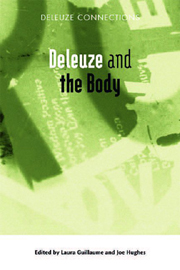Book contents
- Frontmatter
- Contents
- Introduction: Pity the Meat?: Deleuze and the Body
- DELEUZISM
- PRACTICAL DELEUZISM
- 6 The ‘Virtual’ Body and the Strange Persistence of the Flesh: Deleuze, Cyberspace and the Posthuman
- 7 ‘Be(come) Yourself only Better’: Self-transformation and the Materialisation of Images
- 8 An Ethico-Aesthetics of Heroin Chic: Art, Cliché and Capitalism
- 9 Multi-Dimensional Modifications
- 10 Dance and the Passing Moment: Deleuze's Nietzsche
- Notes on Contributors
- Index
10 - Dance and the Passing Moment: Deleuze's Nietzsche
from PRACTICAL DELEUZISM
Published online by Cambridge University Press: 12 September 2012
- Frontmatter
- Contents
- Introduction: Pity the Meat?: Deleuze and the Body
- DELEUZISM
- PRACTICAL DELEUZISM
- 6 The ‘Virtual’ Body and the Strange Persistence of the Flesh: Deleuze, Cyberspace and the Posthuman
- 7 ‘Be(come) Yourself only Better’: Self-transformation and the Materialisation of Images
- 8 An Ethico-Aesthetics of Heroin Chic: Art, Cliché and Capitalism
- 9 Multi-Dimensional Modifications
- 10 Dance and the Passing Moment: Deleuze's Nietzsche
- Notes on Contributors
- Index
Summary
Nietzsche's Image of Thought
According to Deleuze, the image of thought in Nietzsche does not bear upon truth or falsity but draws instead upon the nuances of evaluation and interpretation. Deleuze depicts Nietzschean thought as that which produces movement, bursts of activity, rather than something that simply and inertly pictures or represents the world. The figure of activity persists in Nietzsche's work and in Deleuze's reading of it. Inasmuch as a text activates, inasmuch as a cluster of concepts can indeed provoke movement, Deleuze's Nietzsche aims to provoke a better kind of life. This Nietzsche discerns life, through evaluating and selecting certain kinds of activity over others. It asserts a form of life whose commitment is to all that which is affirmative.
The affirmative type is not us. We are not affirmative types. This is nothing personal. It is just that the positive value of Nietzsche's thought locates itself apart from the structures of the self. Deleuze makes it clear that, from a critical point of view, the self is a sick, pathological structure which has no ongoing future. Somewhat paradoxically, what does endure is difference, or more precisely, the activity of differentiation. This is becoming, and its endurance is what Deleuze dubs the being of becoming, whose perpetual form is the eternal return.
For Deleuze, Nietzsche's thought is organised around two central themes, force and power – or rather, forces and their relations, power and its productions.
- Type
- Chapter
- Information
- Deleuze and the Body , pp. 203 - 223Publisher: Edinburgh University PressPrint publication year: 2011



